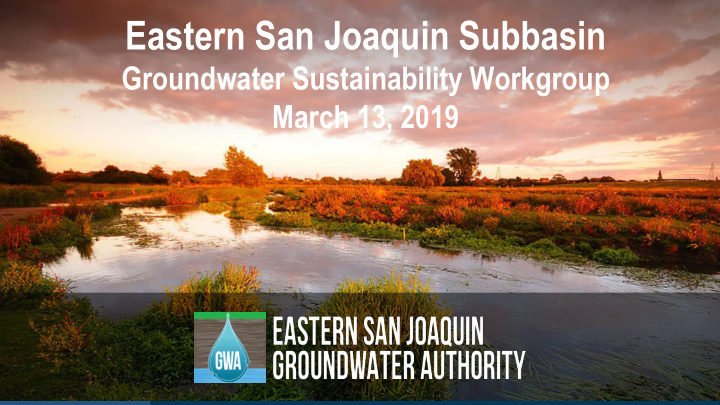



Eastern San Joaquin Subbasin Groundwater Sustainability Workgroup March 13, 2019
Agenda • Meeting Objectives • Roadmap Update • Groundwater-Dependent Ecosystems • Policy Elements Related to Implementation Plan • Announcements 2
Meeting Objectives
Meeting Objectives 1. Review and discuss groundwater-dependent ecosystems (GDEs) • Working session: Map mark up activity to ground-truth areas identified as potential GDEs based on preliminary analysis 2. Review and Discuss Advisory Committee recommendations on policy decisions related to Implementation Plan 3. Consider approaches to addressing undeveloped agricultural land • Discussion Item: Options for addressing undeveloped agricultural land in the Implementation Plan 4
Roadmap and Deliverables Update 4
Updated Schedule to Include Administrative Review Period Reminder from last time: There was a request for an administrative review of the chapters by GSA attorneys/staff prior to release to the GWA Board, Advisory Committee, and the public. 6
Updated GSP Deliverables Review Schedule BOARD Possible Staff provide MEETING Public BOARD response to BOARD Public Draft#1 Public Final Draft JPA Board - Draft#2 MEETING comments/ GSA MEETING GSA Final goes to Board Review of GSP Deliverable Discussion (if goes to JPA Board discussion of Review JPA Board Approval for Review Period Distributed areas of Board for – Action proposed Action disagreement) Review revisions Bundle 1 (Administrative July 10- May 1 May 8 June 5 June 12 Sept 15 Oct 15 Nov 5 Nov 13 Dec/Jan Information; Plan Aug 25 Area; HCM) Bundle 2 July 10- (Water Budget – June 5 June 12 July 1 July 10 Sept 15 Oct 15 Nov 5 Nov 13 Dec/Jan Aug 25 at basin-scale) Bundle 3 (Undesirable Results & Minimum July 10- June 5 June 12 July 1 July 10 Sept 15 Oct 15 Nov 5 Nov 13 Dec/Jan Thresholds, Aug 25 Monitoring Network, Projects)
Groundwater-Dependent Ecosystems
Preliminary Methodology and Results • Today we are presenting a preliminary methodology for identifying GDEs in the Subbasin • The draft results will be reviewed with GSAs to ground-truth areas that have and have not been identified as GDEs areas through this analysis 9
Preliminary Methodology for Assessing GDEs • DWR’s Natural Communities Commonly Associated with Groundwater (NCCAG) dataset was used, developed with The Nature Conservancy • Areas with access to supplemental water supplies were removed, including ▪ Managed wetlands and areas without shallow groundwater ▪ Areas adjacent to canals and ditches, irrigated ag fields, losing streams, perennial rivers, and managed wetlands. 10
Full NCCAG Dataset 11
NCCAG Dataset: Potential GDEs and Other Buffers Used Drawn from area of shallow DTW 30+ ft. DTW measurements Managed 150 ft. Wetland Adjacent to Ag. 50 ft. Losing or Perennial 150 ft. Streams Canals and 150 ft. Ditches 12
NCCAG Dataset: Potential GDEs and Other 13
Identified Potential GDEs 14
Working Session • Map mark up activity to ground-truth areas identified as potential GDEs based on preliminary analysis 15
Policy Elements Related to Implementation Plan 4
Policy Elements Related to Implementation Plan 1. Water Budget Planning Estimates 2. Sustainability Indicators 3. Monitoring, Measuring and Model Refinements 4. Project Implementation 5. Management Actions 17
1. Water Budget Planning Estimates – Issue Summary Due to uncertainties inherent in projecting future groundwater conditions, a range of assumptions can be made in determining water budget planning estimates for long-term average imbalance and sustainable yield, which will impact planning targets. Planning Estimates • Long-term Average GW Deficit (low-end, average, high-end) • Pumping Offset Needed to Meet Sustainable Yield (low-end, average, high-end) 18
2. Sustainability Indicators – Issue Summary SGMA requires the GSP to address six sustainability indicators: • Chronic Lowering of Groundwater Levels • Reduction in Groundwater Storage • Seawater Intrusion • Degraded Water Quality • Land Subsidence • Depletion of Interconnected Surface Water SGMA allows Basins to not fully address an indicator if the sustainability indicator is not applicable to their basin. To do this, GSAs must provide evidence that the indicator does not exist and could not occur. 19
3. Monitoring, Measuring, and Model Refinements – Issue Summary Following GSP approval, SGMA compliance will require Basin- scale monitoring and reporting, as well as model validation and verification at the Subbasin scale. The following activities are expected to be required. • Monitoring and reporting • Data collection and analysis • Administrative actions • 5-year update • DMS updates • Public outreach • Website maintenance • Legal support (potentially) • Grant writing 20
4. Project Implementation – Issue Summary SGMA projects that go into the GSP Implementation Plan can be developed and implemented at the GSA level, at a regional level, or the Subbasin level. The level at which projects are implements could have implications for project implementation, authority, control, and cost. 21
5. Management Actions – Issue Summary SGMA requires GSAs to implement projects and management actions to reach sustainability. What kinds of projects and management actions should be included in the GSP implementation plan? 22
Policy Elements Related to Implementation Plan: Approach to Undeveloped Ag. Land 4
Discussion • Consider and discuss various approaches to addressing undeveloped agricultural land 24
Announcements
Eastern San Joaquin Subbasin Groundwater Sustainability Workgroup March 13, 2019
Recommend
More recommend